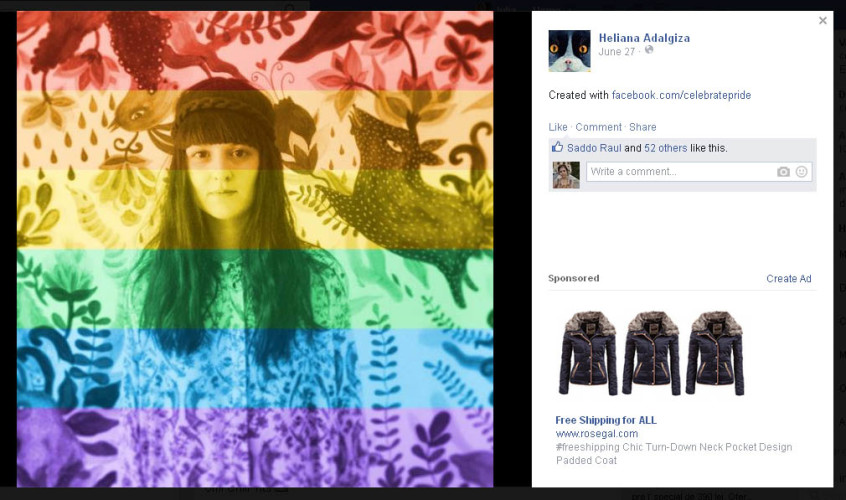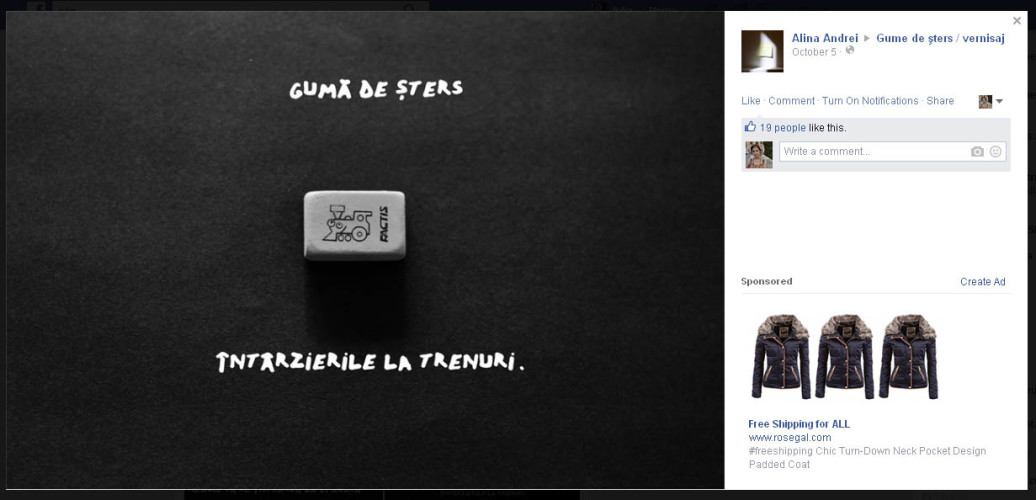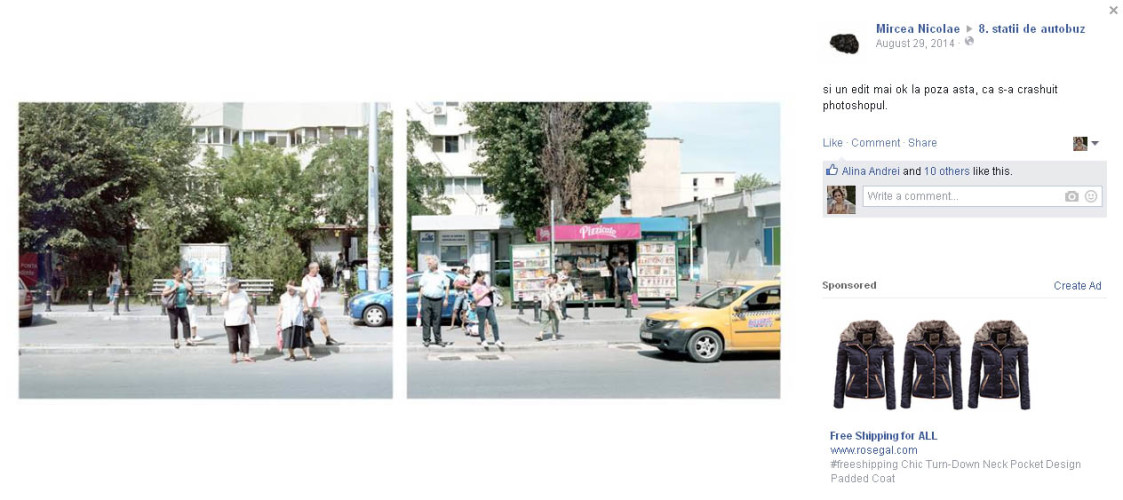I will distinguish between two ways of displaying works on Facebook: the first is a kind of permanent exhibition on the Facebook profile, where artistic projects are disseminated along with information about the artist’s life. This mix of art and (auto)biography makes it so that any references to private life (which we usually meet among most users loyal to the platform, and which have a minimum reality content) are over-aestheticized. We may find many examples of this, but I am particularly drawn to Heliana Adalgiza – the Facebook profile, Heliana Rotariu – the person, or Aitch – the artist, whose account displays everything from travel snaps, to moments of everyday life, works, workshop intervals, ongoing or completed projects, an album named ‘Uhla’, various photos falling within personal and artistic spheres, as well as hybrids between the two that together make for a kind of alluring work-in-progress of a human and professional existence exposed online in the form of what it actually is not.
Such works that have infiltrated personal photos have several notable features in common. Firstly, given that they are collected and classified according to personal aesthetic considerations, unrestrained by rigors of art galleries and curators’ or the public’s requirements, they develop a kind of autonomous existence that conveniently folds on Facebook’s mechanism known to involve an approving response from the public via ‘Like’, ‘Share’ and favorable comments. In this context, a work’s independence is limited by the public’s and Facebook decision-makers’ tolerance, whenever dealing with works that challenge moral or aesthetic boundaries. We are obviously referring to those ‘Community Standards’ that impose a set of ethical rules concerning nudity, sexual content, violence, etc., while ultimately limiting the right to an opinion. If we consider that the artistic act has gained more than 100 years of declared and assumed transgressive attitude, which Facebook overrides in favor of the platform’s popularity, we could say that the general public is the one factor that regulates and filters contents – in our case, artistic contents.
Whether limited or not, the display of artist portfolios on Facebook is ultimately a highly valuable method of advertising and selling personal art for no financial cost to the artist. This method is available to each and everyone, albeit involving a very short time of access to the public or potential buyers. It is what I imagine happened to Vlad Eftenie, who in an article published in ‘Observatorul Cultural’ once mentioned being contacted by OMA Vision to be a photographer for the Enescu Festival, said company having previously followed photos he had posted on social networks (Observatorul Cultural, no. 535, p. 14). A very telling example is that of Paul Heard, an English artist who gained notoriety through self-promoting and selling paintings on Facebook, and who admitted to have scored many of his opportunities via online social platforms (‘Artists and Digital: Why Social Media Is the New Gallery’). On Heard’s Twitter account, various photos taken with his pet are interspersed with others of his artworks, thus allowing for his audience to be more receptive to artistic creation – since, let’s face it, we all love some (auto) biographical content. In my view, that is exactly the main reason why certain artists enjoy more popularity online: the posts attract comments and shares all the more as the author’s personal underlying involvement may be perceived.
The second type of Facebook exhibition – the more temporary one – can be identified as events taking place on Facebook, with the online environment acting as exhibition space.
The first question to be considered is: Why would an exhibiting artist choose Facebook over a gallery? Does contact with a gallery somehow imply a hidden institutional constraint where artworks are valued, exhibited and sold, or is the Facebook solution merely a cheap alternative, besides being accessible to any kind of audience? From my own experience, non-artist curators often take a discriminatory attitude toward artworks, in the sense of calculating value on the basis of potential profit only. While that may be quite fair from an economic standpoint, what happens when the public’s artistic requirements are circumscribed to culturally patchy visual education? The obvious happens: an artist’s works become vehicles for commercial galleries’ and customers’ interests, while their own artistic value takes a plunge. There is no time left for experiments, reinvention, or for any personal (re)assessment in general. Hence the growing tendency toward cultivating alternative spaces. Alina Andrei’s ‘Gume de şters’ (‘Erasers’) event, as held on Facebook on October 5th this year, can easily be set in this context. The show actually involved two different places, one being the ‘Dryer’, which, as stated by the artist on the event page, is located inside an old communist buildings’s dryer room. The dryer works as a temporary art space at the crossroads between a workshop, a virtual gallery and a secret café for sharing stories and gossip. Curiously enough, however, that is not where the public was invited at the opening day; instead, Facebook was turned into a second exhibition place. With this art show, the social network accounts for a context which, at least partially, adjusts itself to the artist’s requirements for an alternative space where we do not blab before hearing the long-expected speech and do not care to huddle over a glass of wine and biscuits. In a way, while having said “alternative space”, I recalled to myself the term’s original meaning, harking back to when such spaces first appeared in the US: in attics or abandoned buildings whose original functionality was diverted to serve as a workshop, but equally as an exhibition space, and whose character was temporary, as everything posted on Facebook is, to be lost somewhere in the complicated news network each time you hit ‘Refresh’. At the same time, Facebook allows one to find a little bit of everything and from everywhere as tiny puzzle pieces; therefore, once acknowledging that an artwork has distinct aesthetic qualities depending on where it is exhibited, Alinas’s photography – along with artwork in general – becomes contaminated by a human-virtual network upon being posted online; a network wherein it find sufficient space, but is never really in place.
The same goes for the works that were part of Mircea Nicolae’s exhibition series in 2014, each month, for a year – ‘The Facebook show’. He claimed that this way, he did not have to waste time looking for an exhibition space, and the visual information reached a lot of people very quickly. This event is situated in an experimental area where the artistic route is unintentionally incomplete and leaves room for further revisions. Along with photography and film, the artist also puts forward a concept. And here we can talk about the artist’s predilection for unusual spaces, if one recalls Mircea Nicolae’s “apartment gallery” that he built in his own living room. What can we make of this repurposing of apartments, dryer rooms, elevators by George Roşu in ‘The Ups and Downs of being an artist’ and in the online environment? Can we call it an alternative to galleries, or an alternative way of thinking?
In any case, Facebook is an interesting phenomenon for the art world because it presents new forms of subsistence and resistance for artists in a hedonistic society that is based on the idea that If you’re not having fun, you’re doing it wrong.
POSTED BY
Iulia Morcov
Iulia Morcov is a visual artist. She graduated from the National Arts University in Bucharest in 2007, and received her Ph.D. at the same institution in 2013. Her research topic was the problematics o...
iuliamorcov.blogspot.ro





Comments are closed here.